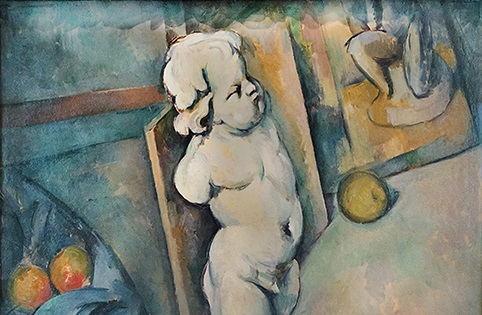Still Life with Plaster Cupid was painted circa 1894 by Paul Cézanne. Cézanne was a 19-20th century French artist and Post-Impressionist painter. At first glance, this painting looks like a still-life painting in general. It depicts fruits on the table with a cupid little plaster cast without arms.

Paul Cézanne, Still Life with Plaster Cupid, c. 1894 oil on canvas, 70.6 x 57.3 cm (Courtauld Gallery, London) (photo: Steven Zucker, CC BY-NC-SA 2.0) https://www.khanacademy.org/
What makes this painting special is the perspective used by Cézanne. It seems to be painted from one angle, but actually not. We can observe it from the background, the position of the plaster statue, and the fruits around it. The background makes the viewers wonder whether it is a table, floor, or a piece of drapery. This background looks slanted with a fruit the size of a ball rolling on it. The little angel in the center was painted in a contrapposto position to show it’s a moving object. Contrapposto is a human figure standing with most of its weight on one foot. Its shoulders, arms, hips, and legs look twist in the axial plane. The statue’s hip is at a different angle from the foot. The foot comes toward us, but the hip is a little bit turning to the right. The fruits around it also look slightly moving. This painting also has odd shadows that result from shifted light.
By twisting everything and using mixed perspectives, Cézanne would like to paint a move. In other words, he wanted to represent not only two dimensions, but also another dimension, that is time.
James Fox, a British art historian, supposed that Cézanne produced his masterpiece, influenced by the invention of new industrial technology in his age, like an incandescent lamp, the sewing machine, the tinfoil phonograph, and the big-box telephone. Fox called it an era of unprecedented speed and change. Tradition, certainty, and solid ground gradually dissolved. People were fascinated by speed. Painters also want to capture speed in their paintings.
Until now, Cézanne’s Plaster Cupid painting is inspirational to show how changes in space and time can be depicted in two-dimensional media.
Cézanne, Still Life with Plaster Cupid


